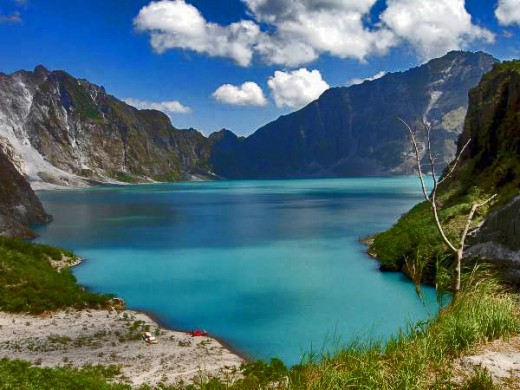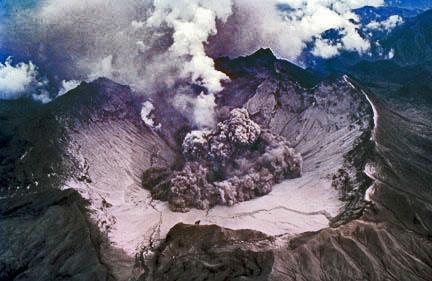Mount Pinatubo, an active stratovolcano just like Mount Mayon Volcano is situated in the island of Luzon. It is mainly in the intersection of the borders of Zambales, Tarlac and Pampanga in the Philippines. It is located in the Tri-Cabusilan Mountain range separating the west coast of Luzon from the central plains. During the Ancestral Pinatubo times, the volcano was a stratovolcano made of andesite and dacite and as well as heavily eroded. Dense forest covered the volcano and supported several thousand indigenous people which are the Aeta.
Mount Pinatubo was called Ancestral Pinatubo before the most explosive eruptions happened. The activity of Ancestral Pinatubo seems to have begun about 1.1 million years ago. It may have reached the height of 7,550 ft. above sea level based on profile fitting to the remaining lower slopes.
The Modern Mount Pinatubo was born after the most explosive eruption in its history occurred. The eruption deposited pyroclastic flow material up to 100 meters thick on all sides of the mountain. Scientist estimated that the most recent eruption before the 1991 eruption of Mount Pinatubo happened 450 years ago and after that the volcano lay dormant.
Before the destructive 1991 eruption, Mount Pinatubo is unknown to most people in the surrounding area. It is 5,725 ft above sea level but only about 600 m above nearby plains, and about 200 m higher than surrounding peaks. Mount Pinatubo is part of a chain of volcanoes which lie along the western side of the edge of the island of Luzon which is considered as West Luzon volcanic arc. They arise due to magma occlusion from this subduction plate boundary.
The word “Pinatubo” means “grown” in English which suggest knowledge of its previous eruption in about AD 1500. Or it might instead mean fertile land where crops can be made to grow. The Aetas have lived for several centuries in the slopes of the Mount Pinatubo. They fled to the mountains during the Spanish era to escape persecutions. They are considered a hunter-gatherer people who can survive in dense jungles and have grown staple crops like wheat.
The Mount Pinatubo’s ultra-Plinian eruption in June 1991 produced the second largest terrestrial eruption of the 20th century (after the 1912 eruption of Novarupta) and the largest eruption in living memory. In July 1990, a magnitude 7.8 earthquake hit 100 kilometers northeast of Mount Pinatubo which determined to be a result of the reawakening of the volcano. In mid-March 1991, villagers around Mount Pinatubo began feeling earthquakes and volcanologists began to study the mountain. On April 2, small explosions from vents dusted local villages with ash. The first evacuations of 5,000 people were ordered later that month.
On June 5, 1991, alert level 3 was raised due to a possible major eruption. It was raised to alert level 5 on June 7 because of lava dome and evacuated 25,000 people which are within the 20 kilometers danger zone. 18,000 personnel at Clark Air Base which is a U.S. military installation near the volcano evacuated the area. On June 12, the danger radius was extended to 30 kilometers and evacuated 58,000 people.
Mount Pinatubo erupted on June 15, 1991 at 1:42 pm local time. The eruption lasted for nine hours and caused numerous large earthquakes due to the collapse of the summit of Mount Pinatubo and the creation of a caldera. The caldera reduced the peak from 5725 ft to 4872 ft high is 2.5 kilometers in diameter.
Adding to the destructive eruption of Mount Pinatubo was Tropical Storm Yunya was passing 75 km to the northeast of Mount Pinatubo which cause large amount of rainfall in the region. The ash that was ejected from the volcano mixed with the water vapor in the air to cause a rainfall of tephra that fell across almost the entire island of Luzon. This has then caused massive lahars which killed hundreds of people.
The world was greatly affected by the 1991 Mount Pinatubo eruption. The economic development of the affected region and of the country was severely hampered. Global environmental effects because of an enormous volume of lava and ash injected significant quantities of aerosols and dust into the stratosphere. This very large stratospheric injection resulted in a reduction in the normal amount of sunlight reaching the Earth’s surface by roughly 10%. The eruption had a significant effect on ozone levels in the atmosphere, causing a large increase in the destruction rate of ozone. The stratospheric cloud from the eruption persisted in the atmosphere for three years after the eruption.
After the 1991 Mount Pinatubo eruption, a crater lake called Pinatubo Lake was formed in the 1991 caldera with the 1992 lava dome forming an island. At first, the lake was small, hot and highly acidic, with a minimum pH of 2 and a temperature of about 40 °C. Abundant rainfall cooled and diluted the lake, lowering the temperature to 26 °C and raising the pH to 5.5 by 2003.
Today the Lake Pinatubo has been developed for tourism. A lot of adventures are offered such as hiking, 4×4 jeep services, and kayaking. There is even a massage spa and restaurant. You can also take a dip at the Mount Pinatubo hot springs. All these and more were offered even if the volcano is active. They always check with PHIVOLCS with the latest volcano activity for safety.
This page is last updated on


 Mark Anthony Maranga is an Educator-Parent to his 3 Homeschooling Kids. He sells
Mark Anthony Maranga is an Educator-Parent to his 3 Homeschooling Kids. He sells 










Hi,
I went to Mt. Pinatubo last March 17, 2012 and had a great, fun and challenging experience.
do not book using ensogo and trekpros. see my experience, very poor service. All I want is to enjoy and see Mt. Pinatubo, but now I’m all stressed out. 🙁
http://ofloveandpancakes.blogspot.com/2012/01/ensogo-discount-vouchers.html
Hi mark! hope you can also feature capones island, anawangin cove, camara island and nagsasa cove in zambales. thanks!!!
Hi Ennie,
I’ll be in Zambales early next year so probably I can feature the tourist spots you mentioned above. Thanks!